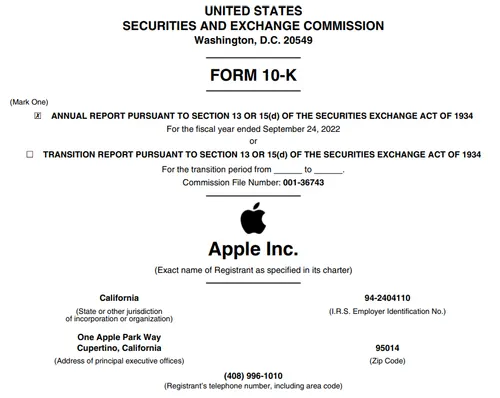Our partner, XM, lets you access a free demo account to apply your knowledge.
No hidden costs, no tricks.

The U.S. stock market is home to thousands of sought-after companies that offer their shares to local and international investors. This increases the demand for transparency in terms of financial performance, as well as governance-related issues.
For this reason, the Securities and Exchange Commission, or the SEC, enforces regulations and compliance rules and reporting standards for every public company to adhere to if they wish to trade their shares continuously on one of the major stock exchanges in the world, such as the New York Stock Exchange and the Nasdaq.
The Form 10-K is a comprehensive annual report filed by publicly traded companies with the U.S. Securities and Exchange Commission (SEC).
The form provides a detailed overview of a company's financial performance and operations.
Shareholders and analysts use this information to assess the financial health of the company, as well as evaluate its strategic direction and long-term commitments.
This data is incredibly important and accurately filing the Form 10-K is essential for the United States stock market to function properly.
If you are a beginner trader and would like to know more about the information included in the Form 10-K, this Investfox guide is for you.
As already mentioned, the Form 10-K consists of comprehensive financial statements from a specific fiscal accounting year of the filing company and this information is made public at the same date every year.
Failing to file the form in due time results in harsh financial penalties from the SEC and a continuous failure to do so will result in delisting of the company’s shares.
Some of the most important pieces of information included in the Form 10-K include:
All of the above are key data points that analysts and investors use to assess the health and direction of a particular public company to then decide whether the company will be able to achieve its short and long-term objectives as things stand in the present.
To better understand how a Form 10-K works and what is included in it, let’s look at the form filed by one of the most sought-after public companies and the largest stock in the world - Apple Inc (AAPL):

The form includes vital accounting statements, such as the income statement, balance sheet, and the statement of cash flows, which show the revenues, expenses, net income, assets, liabilities, equity, and the movement of cash resources in and out of the business.
Prospective and existing shareholders of Apple Inc can use this information to see what the current state of the company is and what the forward-looking statements point out as the risks and opportunities facing Apple in the future.
The Form 10-K is typically filed annually with the U.S. Securities and Exchange Commission (SEC). Companies, such as Apple, must submit their 10-K within 60 to 90 days after the end of their fiscal year.
Our partner, XM, lets you access a free demo account to apply your knowledge.
No hidden costs, no tricks.
The Form 10-K includes a company's audited financial statements, management discussion and analysis, business overview, risk factors, information on corporate governance, legal proceedings, and other pertinent details, providing a comprehensive view of its financial health and operations.
Publicly traded companies in the United States, including those listed on stock exchanges like the New York Stock Exchange (NYSE) or NASDAQ, are required to file the Form 10-K. This filing is mandated by the U.S. Securities and Exchange Commission (SEC).
Companies typically file Form 10-K annually with the U.S. Securities and Exchange Commission (SEC). The filing deadline is within 60 to 90 days after the end of the company's fiscal year.